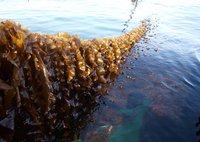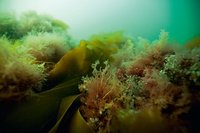When renewable energy and an improved marine environment go hand in hand
How can we manage a sustainable production of fossil-free offshore wind power, and mussels and seaweed in the same marine area? And what are the effects on the marine environment and on biodiversity? This will be elucidated in a new collaboration between Danish universities and private companies.

Denmark is surrounded by sea offering excellent conditions for wind energy. A broad political majority will exploit this to create more fossil-free energy. Therefore, over the next seven years, Denmark’s energy production from offshore wind will - as a minimum - be quadrupled.
At the same time, there is a growing demand for food with a low environmental footprint, and this can be produced at sea – in the form of mussels and seaweed.
It is well-known that the marine environment is under strong pressure. So - will it be possible to solve some of the challenges regarding fossil-free production of energy and sustainable food and the marine environment at the same time?
A collaborative project will answer this question when Aarhus University, the energy company Vattenfall, Technical University of Denmark, University of Copenhagen, the seaweed and mussel producer, Kerteminde Seafarm and the Kattegatcentre join forces to develop a model for how to combine offshore wind farms, seaweed and mussel production and environmental monitoring in the same marine area.
Great demand for space at sea
There is a great demand for space at sea for fishing, shipping, wind farms, raw materials extraction, aquaculture, and infrastructure for power, gas and data, and for recreational activities. At the same time there is an international call for more Marine Protected areas - also in the open sea.
“It is our goal to create a so-called “multi-use platform” where we produce energy and food in the same marine area, while simultaneously investigating the effects on the marine environment and biodiversity in that area. Developing multi-use can make it possible to exempt other marine areas from activities,” says senior researcher Annette Bruhn, Department of Ecoscience, Aarhus University, who is heading the new partnership.
It is obvious to combine the offshore wind farms with the production of seaweed and mussels, but energy companies also focus on efficient operation of the wind farms.
“Renewable energy companies have traditionally focused on optimising the production of fossil free energy, but we see an increasing focus on contributing positively to biodiversity. Therefore, one of the main objectives of the project is to identify both the challenges and the opportunities that arise when offshore wind farms are combined with other activities,” says Annette Bruhn.
The newly started project has been named WIN@sea, which is an abbreviation of “Wind Energy and Nature-based solutions integrated at sea”.
An investment in the future
The activities will take place at the Danish offshore wind farm Kriegers Flak, which is located east of the Danish island of Møn and is operated by the energy company Vattenfall.
Vattenfall’s purpose is to enable fossil-free living future with the power of renewables, but also to support the development of sustainable practise across sectors.
Large stones are arranged around the wind turbines to protect against erosion of the area around the turbines. These stones also act as artificial reefs, and the project will generate knowledge about which type of biodiversity is linked to the artificial hard-bottom habitats that the turbine towers and the stones together provide.
“As wind turbines at sea cover larger and larger areas, it makes very good sense for us to look at how the areas can be used for several purposes. Therefore, we have decided to invest both time and money in the groundbreaking project WIN@sea,” says marine biologist Matthieu Povidis-Delefosse from Vattenfall.
“At Vattenfall, our purpose is to create a fossil-free future, but it must not be at the expense of the environment. We are working towards ensuring that our projects contribute positively to biodiversity. If offshore wind farms can also be used to grow seaweed and mussels, we can remove nutrients from the sea water in which they grow. This will extend the positive effects of wind farm for the society,” says Matthieu Povidis-Delefosse.
No off-the-shelf items

There are no easy solutions when you grow seaweed and mussels at sea. Depth, bottom conditions, currents and waves vary, and the cultivation systems must therefore be tailored to fit the local conditions.
In WIN@sea, the company Kerteminde Seafarm, together with the researchers involved in the project, will study which systems function best in the exposed marine area near Kriegers Flak, where the depth is more than 20 metres and where the waves can be up to 6 metres high.
Facts
- WIN@sea is supported by approx. DKK 18.5 million. The VELUX FOUNDATION supports the project with DKK 5 million, the AAGE V. JENSEN NATURE FOUNDATION supports activities related to biodiversity and communication with DKK 2.5 million, and the EU supports the project with DKK 11 million via the lighthouse project OLAMUR.
- The activities will take place in the period 2023-2026 at Scandinavia's largest wind farm, Kriegers Flak, which is located approx. 15-40 kilometres east of Møn.
- WIN@sea will prepare proposals for guidelines for the authorities to use in the future in connection with the establishment of various operations at sea.
- WIN@sea will map animal and plant life on wind turbines and erosion control structures at the wind turbines at Kriegers Flak and compare it with the fauna and flora on natural reefs in the area to find out how offshore wind farms affect biodiversity.
- The project will also examine how the offshore wind farm can be used as a platform for measuring equipment that can contribute to better monitoring of the marine environment. This includes, among other things, measurement of power, waves, salinity and temperature, but also the development of equipment that can count the prevalence of jellyfish.
- The results of WIN@sea will be disseminated widely through i.e. exhibitions and teaching at the Kattegatcentre, involvement of citizens in test fishing and participation in events such as Denmark’s Political Festival and the People’s Festival of Nature.
- WIN@sea is part of the EU lighthouse project OLAMUR, which also concerns combining offshore wind farms with, among other things, food production within a so-called multi-use concept.
Further information about WIN@sea:
- Senior researcher Annette Bruhn, Department of Ecoscience, Aarhus University. E-mail: anbr@ecos.au.dk, tel.: +45 2963 8034.
- Press officer Mads Krogh, Vattenfall. E-mail: mads.krogh@vattenfall.com, tel.: +45 2217 8178.
- Head of research Lone Thybo Mouritsen, Kattegatcentret. E-mail: lm@kattegatcentret.dk, tel.: +45 2027 6553.
- CEO Mads Hecter, Kerteminde Seafarm. E-mail: mads@seafarmer.dk, tel.: +45 2622 4289.

